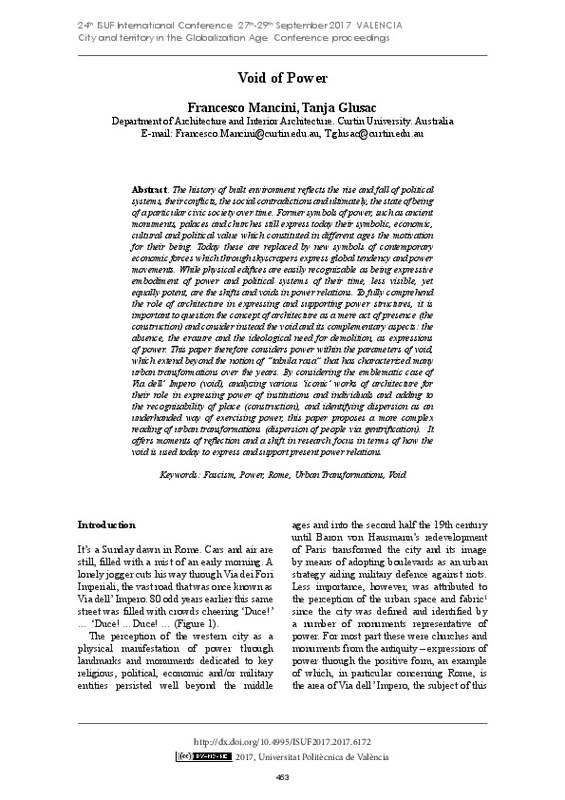JavaScript is disabled for your browser. Some features of this site may not work without it.
Buscar en RiuNet
Listar
Mi cuenta
Estadísticas
Ayuda RiuNet
Admin. UPV
Void of Power
Mostrar el registro sencillo del ítem
Ficheros en el ítem
| dc.contributor.author | Mancini, Francesco
|
es_ES |
| dc.contributor.author | Glusac, Tanja
|
es_ES |
| dc.coverage.spatial | east=12.48670559470736; north=41.89347849842964; name=Via dei Fori Imperiali, 00186 Roma RM, Itàlia | es_ES |
| dc.date.accessioned | 2018-12-18T07:34:15Z | |
| dc.date.available | 2018-12-18T07:34:15Z | |
| dc.date.issued | 2018-04-20 | |
| dc.identifier.isbn | 9788490485743 | |
| dc.identifier.uri | http://hdl.handle.net/10251/114029 | |
| dc.description.abstract | [EN] The history of built environment reflects the rise and fall of political systems, their conflicts, social contradictions and ultimately, the state of being of particular civic societies over time. Former symbols of power, such as ancient monuments, palaces and churches still express their symbolic, economic, cultural and political value which constituted in different ages the motivation for their being. Today these are replaced by new symbols of contemporary economic forces which through skyscrapers express global tendency and power shifts. While such edifices are recognizable embodiments of power and political systems of their time, less visible, yet equally potent, are the shifts and voids in power relations. To fully comprehend the role of architecture in expressing and supporting power structures, it is important to question the concept of architecture as a mere act of presence (construction) and consider instead the void and its complementary aspects: absence, erasure and ideological need for demolition, as expressions of power. This paper considers power within the parameters of void, which extend beyond the notion of “tabula rasa” that has characterized many urban transformations. By considering the emblematic case of Via dell’ Impero, analyzing various ‘iconic’ works of architecture for their role in expressing power of institutions and individuals, and identifying dispersion as an underhanded way of exercising power, this paper proposes a more complex reading of urban transformations. It offers moments of reflection and a shift in research focus in terms of how the void is used today to express and support present power relations. | es_ES |
| dc.format.extent | 9 | es_ES |
| dc.language | Inglés | es_ES |
| dc.publisher | Editorial Universitat Politècnica de València | es_ES |
| dc.relation.ispartof | 24th ISUF International Conference. Book of Papers | es_ES |
| dc.rights | Reconocimiento - No comercial - Sin obra derivada (by-nc-nd) | es_ES |
| dc.subject | Fascism | es_ES |
| dc.subject | Power | es_ES |
| dc.subject | Rome | es_ES |
| dc.subject | Urban transformation | es_ES |
| dc.subject | Void | es_ES |
| dc.title | Void of Power | es_ES |
| dc.type | Capítulo de libro | es_ES |
| dc.type | Comunicación en congreso | es_ES |
| dc.identifier.doi | 10.4995/ISUF2017.2017.6172 | |
| dc.rights.accessRights | Abierto | es_ES |
| dc.description.bibliographicCitation | Mancini, F.; Glusac, T. (2018). Void of Power. En 24th ISUF International Conference. Book of Papers. Editorial Universitat Politècnica de València. 453-461. https://doi.org/10.4995/ISUF2017.2017.6172 | es_ES |
| dc.description.accrualMethod | OCS | es_ES |
| dc.relation.conferencename | 24th ISUF 2017 - City and Territory in the Globalization Age | es_ES |
| dc.relation.conferencedate | Septiembre 27-29,2017 | es_ES |
| dc.relation.conferenceplace | Valencia, Spain | es_ES |
| dc.relation.publisherversion | http://ocs.editorial.upv.es/index.php/ISUF/ISUF2017/paper/view/6172 | es_ES |
| dc.description.upvformatpinicio | 453 | es_ES |
| dc.description.upvformatpfin | 461 | es_ES |
| dc.type.version | info:eu-repo/semantics/publishedVersion | es_ES |
| dc.relation.pasarela | OCS\6172 | es_ES |








